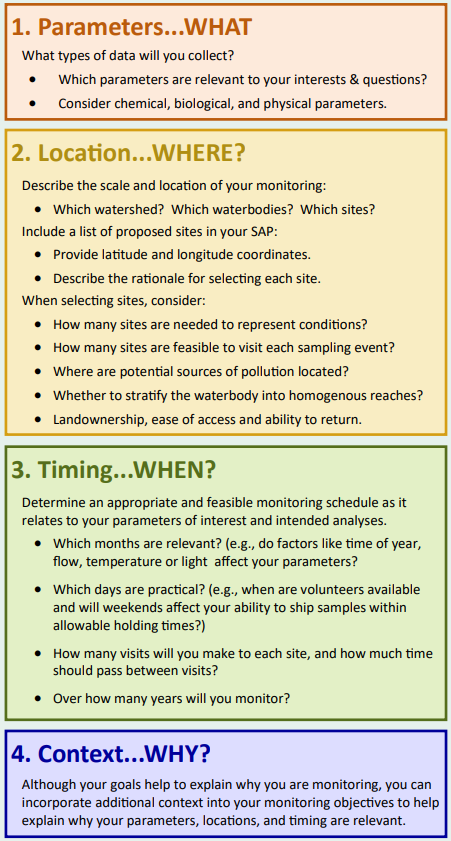Monitoring Objectives Module
This module is intended to support groups who are articulating or refining water monitoring objectives. Anticipate spending approximately 30 minutes to read the content below, click on each of the 6 video links (17 minutes total length), brainstorm and then begin to refine one of your own monitoring objectives.
Designing a water monitoring program that will produce data, which can be used to answer questions, requires thoughtful consideration of the intended outcomes. Clearly articulating monitoring objectives is a useful way to refine and communicate intentions for what, where, when, why data will be collected.
Guidance for articulating monitoring objectives is available in the Volunteer Monitoring Catalogue and the Monitoring Methods Selection Guide (MMSG) overviewed in this 1:39 minute video. Common goals for water monitoring include: determining baseline conditions; pollution source identification; assessing project effectiveness; assessment for trends in water quality; and public engagement/education. The MMSG links these different goals to common parameters of interest and standard operating procedures for monitoring those parameters. Use of the MMSG is outlined in this 4:18 minute video. There are four components of a monitoring objective (What, Where, When, Why) which are described in the Volunteer Monitoring Catalogue and summarized in this 5:11 minute video.
Take five minutes to jot down your ideas about the What, Where, When, and Why of an intended monitoring project or a hypothetical monitoring project.
Three example monitoring objectives are presented in the Volunteer Monitoring Catalogue and are presented below along with explanatory videos. Take a few minutes to consider each of these example objectives.
- Beaver Creek, Nutrients near Anytown – Example Objective 1 video (1:33)
- Deer Creek, Aquatic Habitat – Example Objective 2 video (2:04)
- Rock Creek, Nutrients in Tributaries – Example Objective 3 video (2:38)
Now take another 5 minutes to look at the notes you jotted down for your monitoring project and try to write down a monitoring objective with a structure similar to that in the examples. Sharing draft language for a monitoring objective with project partners and/or workshopping the objective with peers or volunteer monitoring technical service providers is a great way to refine your vision for monitoring and to ensure your data will help answer the questions you are interested in.

